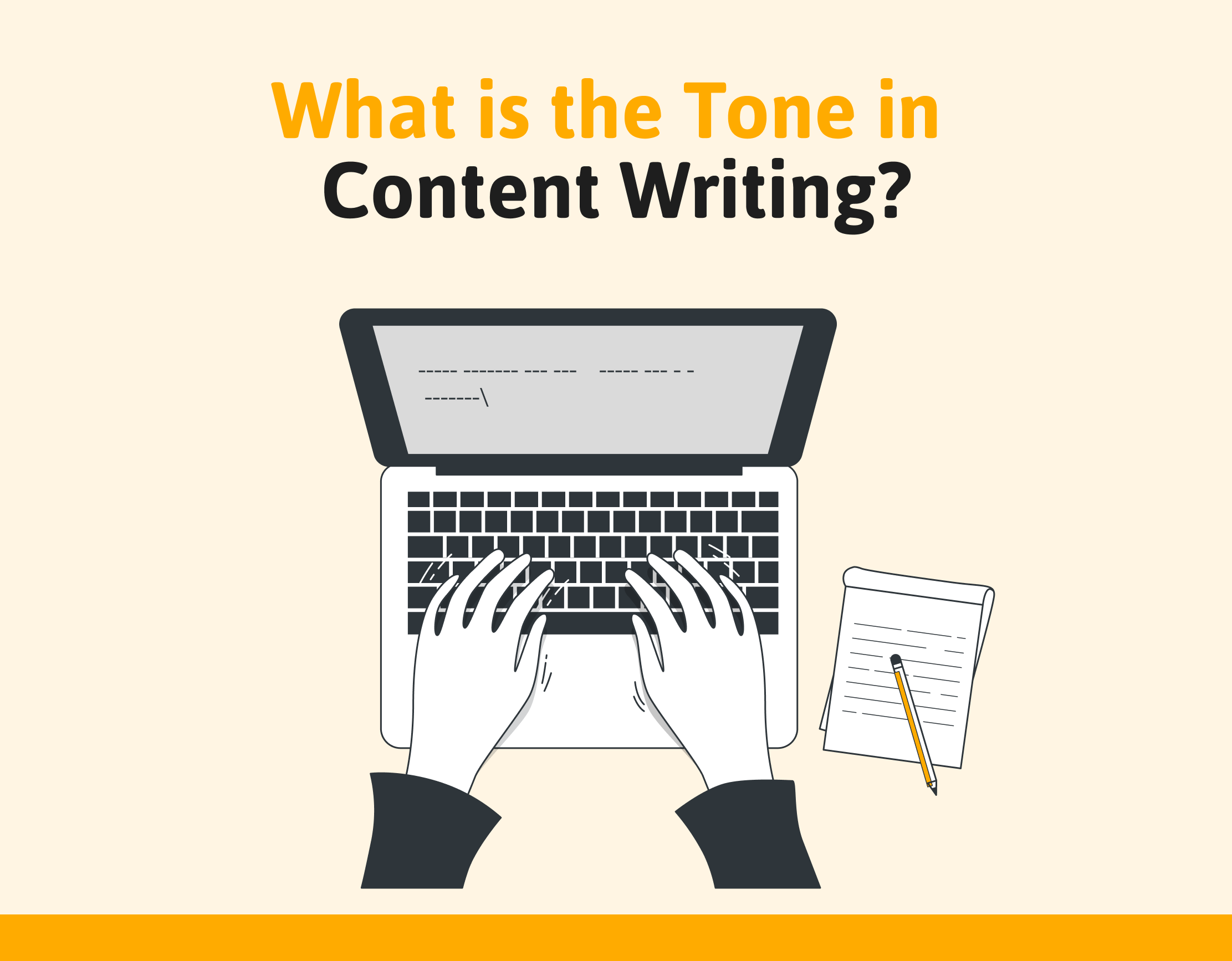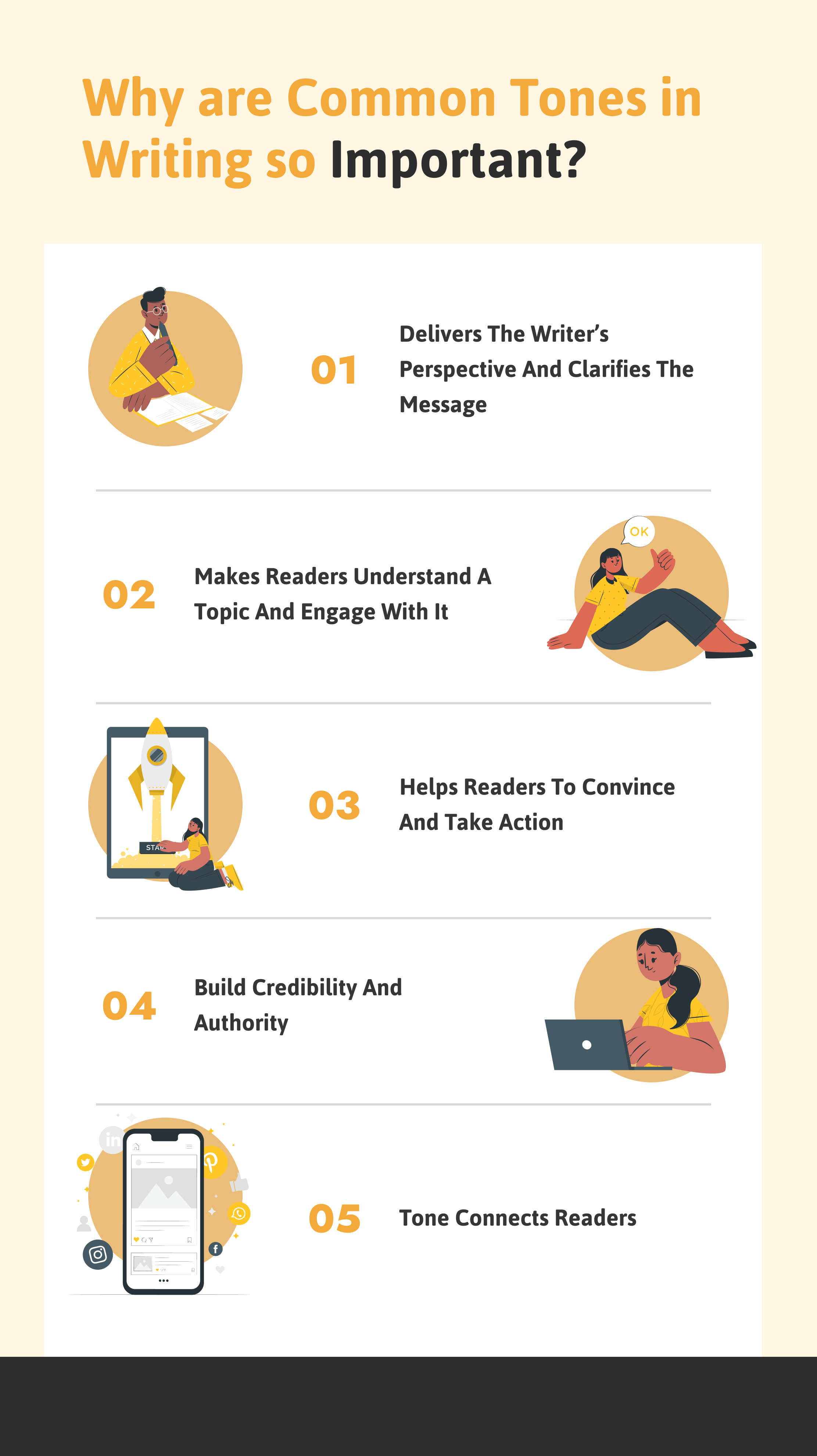Ever become so engrossed in content that you read it over and over again? Do you wonder how the writer distinguishes the emotions, scenes, and different perspectives?
Well, that’s the role of different types of tones in writing, which generally gets manifested by syntax, diction, words, etc.
If you are curious about how to use tones, you are on the right page. In this article, we’ll be discussing different types of tones, their importance, how to use tones in writing, and how to develop one. Let’s get started.
What is the Tone in Content Writing?

The tone is the writer’s vibe to make the reader feel emotion.
What tones in articles mean is what a writer feels or his perspective on a certain topic and the way s/he expresses that in writing by picking words in his writing.
The tone varies based on the topic. Writers can choose to write a whole article following one tone, or they can use several tones as they see fit in one article.
What are the Different Types of Tones in Writing? 14 Types
Like human facial expression or tone of voice, tone of writing also has variations. Those are distinguishable with words and the way of writing.
Here we have created 14 lists of tones in content writing that are mostly used. Let’s check them out:
01. Formal/ Official Tone
A formal tone is the most common type of writing. Most people initiate their writing formally. This type of tone is used everywhere, almost in all types of writing; however, the most common usage is educational, official, business purposes, etc.
Readers of formal writing are knowledgeable and can read between the lines and reciprocate the message as well.
Generally formal writing politely. The words are used fully; there is no contraction or no acronym used. Priority is given to grammar, punctuation, facts, etc.
Even with a negative or assertive tone in writing, a formal tone ensures you are conveying the message directly, professionally, and respectfully to people of all ages.
Formal writing is used in textbooks, business proposals, newspapers, official letters, etc.
Sample sentences that convey a formal tone:
- To whom it may concern.
- Everyone is requested to inform.
02. Informal/ Casual/ Colloquial/ Conversational Tone
An informal or casual tone is another common tone in writing, the opposite of formal. It is the sentences used in conversations or dialogue, for example, slang, phrases, contraction, emoji, etc. For example, we use an informal tone while talking to family or friends.
While writing in an informal tone, grammar, punctuation, or other rules and formalities aren’t maintained that much. Rather, the delivery and understanding of messages are prioritized.
One advantage of an informal tone is that it helps personalize people, so it is most commonly used among already-known people.
An informal tone in writing is used in personal letters, messages, social media posts, blogs, etc.
Here are some sample sentences that convey informal tones:
- We’ve gotta go.
- Jeez, I love this movie!
03. Informational/ Informative Tone
Informational tones for writing are where the information is delivered intended to educate readers based on the topic it has been written.
Informational writing includes many elements like facts, statistics, data, and evidence to weigh the writing. You can often see information tones in educational materials, research reports, etc.
Here are some sample sentences that convey informal tones:
- The human body has 37.2 trillion cells.
- Statistics say that . . .
- According to research, . . .
04. Optimistic Tone
An optimistic tone in writing is one that gives hope, a sense of positivity, and relief to the reader. So, in a sense, the writer thinks positively about a certain topic, and thus s/he delivers that thorough writing.
An optimistic tone encourages the reader to do something either through thought or action, even if there are challenges and troubles. A writer writes in a way that motivates the reader to accept those situations and look at the bright sight.
The optimistic tone is used to assure the reader, mostly seen in literature, especially in prose. Nowadays, many blogs also use it (for example, websites that are dedicated to health and mental well-being).
Here are some examples of optimistic tones used in writing:
- Hang in there; you will do better if you keep practicing.
- It’s okay; we’ve all been through there.
05. Pessimistic/ Sad/ Melancholic Tone
A pessimistic tone describes the tone where writers describe something sad or something bad is about to happen. This might not always be the case in reality; rather, it shows the negative outcome of a possible situation and the feeling one might have.
The melancholic tone is mostly seen in literature, especially in poetry and in the news, which raises concern. The narration makes the reader sympathize with the writer.
Here are some use cases of melancholic tones for writing:
- Environmentalists express their concern about the increasing temperature.
- Considering the price hike, people’s earnings haven’t risen.
06. Persuasion/ Persuasive Tone
The persuasion tone is the tone with which writers inform or describe something or provoke thought, influence or motivate the readers. It may make readers take action on something.
To achieve the right persuasive tone, there are 3 modes to follow. Those are:
- Ethos. Appeal to the writer’s authority or credibility, how the writer/ author presents himself/ herself.
- Logos. Appeal to the reader’s emotions, how the writer/ author presents the situation or message to bring out the emotion of the readers.
- Pathos. Appeal to logic or reason; writers show data, examples, evidence, or personal experience to validate his/ her speech or decision.
This type of tone is directed toward the reader’s emotions. As a result, the tone of persuasion can be assertive, agitated, or calm, by which the writer ignites a thought inside the reader’s mind and makes them agree with his/her points of view.
For example, a persuasive tone for human rights violations will show fury and distress. On the other hand, a persuasive tone for tree plantation will be more gentle, conversational, and understanding. Then again, the same tone used for any product or service advertising will be utterly different and will be amusing and fun.
Here are some sample sentences for the tone of persuasion:
- Smoking causes cancer and many health diseases, including the heart, as it contains nicotine.
- Buy 1, Get 1. Offers are valid for Christmas Day!
07. Friendly/ Playful Tone
A friendly tone is a tone where a writer explains a topic in a soothing and warm way and intends to deliver a message in a rather natural and conversational way. So, this type of tone tends to grab the attention of the reader and engage them.
It can be formal or informal, even with humor, empathy, and positive vibes. This can be used in any type of writing. This tone is lighthearted and playful, so while reading it, I find the words comforting and kind. Nowadays, modern writers mostly incorporate a friendly tone in their approach toward the reader.
Some examples of friendly tones used generally are:
- Happy Birthday! I wish you a happy future.
- So nice of you to bring this for me.
08. Entertaining/ Humorous Tone
When a writer uses a tone accompanying humor, intending for readers to laugh through enjoyable wordings, that is what an entertaining tone is. Thus readers absorb a particular message in a lighthearted manner.
To make the writing entertaining or humorous, writers describe scenes, characters, or messages in a funny, witty, or comedic way.
Generally, content written intended for a humorous tone is generally short yet descriptive and simple yet evokes emotions. Some common examples of humor tones used are anecdotes, memes, advertisements, etc.
Here are some examples:
- The politician was so good at lying, they could convince people that the sky was green,
- He is so forgetful, he forgets his own name and looks it up in his phone.
09. Worried/ Tensed Tone
This tone creates a tense situation where the reader will feel uncertain of the upcoming situation. A worried tone works best on mystery, suspense, and thriller type of writing and goes especially well with story-telling plots.
So, while reading a text that has a tense tone, the reader might feel anxious, afraid as they don’t know what’s going to happen next.
Here are some examples of worried or tense tones:
- He heard a loud thud behind the kitchen door. He turned around slowly and clutched the doorknob, and opened it.
- They walked through the jungle silently. Little did they know, a pair of eyes was observing its prey; with hunger.
10. Curious/ Concerned Tone
A curious tone is when the writer intentionally keeps the reader in the dark, evoking their feeling of learning or knowing more. So, the reader feels intrigued and digs deeper into the knowledge to quench that thirst of not knowing.
Thus, a curious tone serves the purpose of delivering more information or uncovering truth by using the technique of keeping the reader seeking knowledge.
Some examples of using a curious tone in writing are noted below:
- There was a mysterious man living next door. He barely goes out during the daytime.
- The team disappeared! And the mystery remained unsolved.
11. Surprised Tone
You probably understand what a surprised tone is. It is when a writer reveals something unexpected the readers aren’t prepared to accept or never thought of happening. Surprise tone can either be positive or negative, joy or shock anything.
To express surprise in writing, writers incorporate different types of expression. For example, if it’s a novel, the writer might write about the facial expression of the characters, such as raised eyebrows, eyes wide open, etc.
Here are some surprise tone examples used in writing:
- The bell rang. When she opened the door, her eyes widened! There was a giant panda!
- The crowd gasped in shock as he fell from the ladder.
12. Encouraging/Inspiring Tone
An encouraging or inspiring tone is what a writer uses to motivate the reader; the writer tends to support the readers’ perspective, reassure and support them to get away from their negativity and go for the positive thought.
The purpose of an encouraging tone is to get the reader along with the writer by using comforting & hopeful words and being candid & honest.
Here are some example sentences that show encouraging or inspiring tones:
- Take a deep breath; you can do this.
- It’s not a big deal, you’ll find your way.
13. Cooperative/ Conversational Tone
A cooperative tone is the most common tone that you will find in many writings, mostly in workplaces. A cooperative tone is used when there is a collaboration or a matter of teaming up.
So, when there are more than several people included, and everyone’s opinion is important, that’s when a cooperative tone is used, as it makes all the participants engaged in conversation.
In writing, this type of situation is described through words like ‘we’. Here are some examples that convey a cooperative tone in writing:
- I appreciate your feedback; I will check and get back to you soon enough.
- We need to turn around this year. Let’s make the most of this situation.
14. Serious Tone
A serious tone in writing is when a writer describes a topic in a heavy tone, no fun included; rather, it is stern, heavy, and important. Writers use this tone in official, professional, and formal writing when the message needs to be delivered directly without any distractions.
You can find a serious tone in writing on sensitive topics, controversial and issue-related topics. So, when a message is delivered, it creates a sense of suspense and urgency, and thus the reader understands it needs their utmost attention.
Here are examples that help convey seriousness in a writing tone:
- She knew that. . .
- To tell you the truth. . .
Why are Common Tones in Writing so Important?

Depending on circumstances, mood, and incidents, our mood changes. Verbally it’s easier to express. This is why writing tone is important to understand. Having an appropriate tone in writing helps the reader to understand the scenario and what’s going on and be informed about it.
Here are some reasons tone in writing is so important:
- Delivers the writer’s perspective and clarifies the message
Writers do the job of an informant for any topic. They describe, clarify, and show what’s real or what people around the world are thinking or telling— everything through writing, along with delivering their own perception. This is where tone plays an important role in differentiating those differences.
- Makes readers understand a topic and engage with it
It depends on how the reader perceives the same topic differently. So, to bring the unified or similar idea together, tone can perform as a means to connect. It helps readers to understand how a certain situation is flowing and how it is being translated, and it also makes them feel certain emotions.
- Helps readers to convince and take action
Using the right words helps strengthen the tone of writing; as a result, it gets easier to convince writers. You can choose to educate readers, make them agree with you, or even make them purchase something.
- Build credibility and authority
Writing not only persuades the reader but also strengthens the base of a writer’s skill. Getting used to writing in different tones will help you understand slight changes in tone, and not only can you easily understand others’ writing, but you can also improve your writing as well.
Different tone helps establish a different persona among the readers. For example, if you write in an informal tone, readers will find you someone whom you can easily get along with. If you write in a serious tone, they may consider you someone knowledgeable in topics. Thus you create credibility among them.
- Tone connects readers
The right tone helps the reader connect with the message or content. Tones make them feel positive, sad, or amused or other emotions, create a mood, and thus they can understand the piece of writing they read; and grasp it’s intended meaning.
How to Use Writing Tones to Connect with Your Audience?
The tone is the vibe the writer delivers; it has the power to influence a reader’s mind and thought.
To use writing tones that connect the readers/ audience, you have to consider the situation, surroundings, and people.
Generally, writers use different tones to develop their writing; they decide the tone based on the audience. This is like selecting an age-based writing tone. For example:
- Use a jovial, colloquial, energetic tone if you are targeting kids & youngsters.
- Use a formal tone if your target audiences are professionals.
- Write in a respected, cooperative, and conversational tone if you are targeting the older generation.
You don’t have to stick to these, though. Feel free to customize them as you see fit.
Also, the writing tone between content writing and copywriting is also different. While content may convey different tones, copywriting typically describes a single tone.
What tone is for SEO content writing?
The tones for content writing vary mostly formal, casual, serious, and friendly based on the topic that needs to be described. Through elaboration and description, content tends to tell and inform the reader about a topic. Thus, content generally is lengthy in size. The recommended content length for SEO is between 2000-3000.
What tone is for business copywriting?
The tone for copywriting can be humorous, funny, entertaining, or upbeat. It tends to be short and concise, for example, social media posts or advertisement content. Copywriting is intended to pursue the reader to either purchase something or take action (like clicking on a button or visiting a certain webpage etc.).
How to Develop Your Own Content Writing Style for Your Online Business?
This is how you can develop your own writing style. Conduct market research. Determine & study the target audience. Check your competitor’s approach toward the target audience, but don’t copy.
Then comes the challenging part. Writing is a part of marketing as the online platform is already crowded. So, you have to be creative with your brand tone.
Please remember developing a unique writing style requires time and practice. The more effort you put into your practice, the more assured you will be about your writing style.
Also, on Google, you’ll find many theories, strategies, steps, and aspects that experts suggest. Following those will also help you find your unique writing style.
Highlights
We’re about to end the article. Before we conclude, here is a quick overview of what we’ve learned so far.
- The tone is the writer’s attitude on a certain topic.
- Tones in writing are important for clarifying a message, making the reader understand, and building credibility among them.
- There are different types of tones available in writing. The use cases vary based on how the writer wants the reader to perceive them.
- Writers use different types of tones to connect readers based on the situation, surroundings, and people.
- Also, the tone varies between content writing and copywriting.
- By writing for different niches, you can gradually develop your own content writing style.
FAQs on Writing Tones in Articles
What type of writing is a product description?
A product description has an informational tone; thus, it is informative content. It is used as part of marketing to explain products’ features, pros & cons, price, operating process, and more.
What is the best style of writing for blog content?
The best style of writing blog content is to make it visually scannable. So, use proper heading tags, short paragraphs, bullets & lists, and CTA by following the brands’ tone.
What is a good tone for a website’s service page?
Using a conversational tone works best for a website’s service page. It can be formal or casual, merged with an encouraging tone that motivates the reader to take action.
How do you decide what tone of voice to write in?
To decide what tone of voice to use in writing, consider your topic and the target audience first. Keep in mind how your brand wants to approach them. This will help you fixate on the tone you should use.
In Conclusion
Today’s world is highly commercial and competitive. You have to be on-brand to attract the right audience.
If your brand is struggling to find or can’t follow through with the right tone, you should contact professional writers to develop tactics.
When a brand message is delivered with the right approach with the right tone, the target audience is bound to take a look.
So, write it out; till you find your tone. Hopefully, you can make things work to your advantage.
Happy writing!





